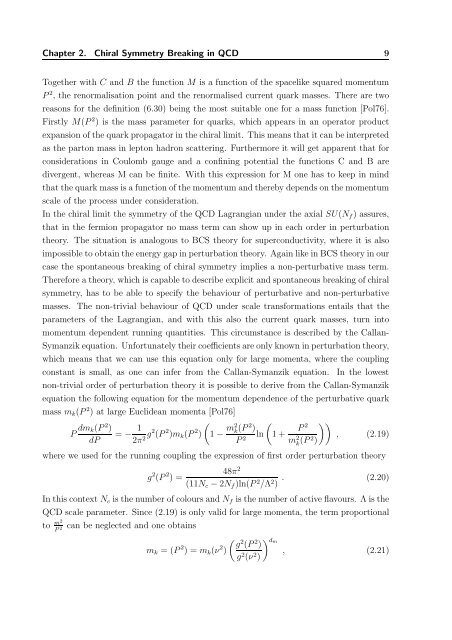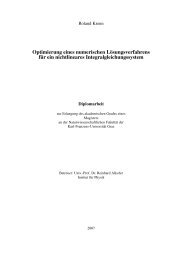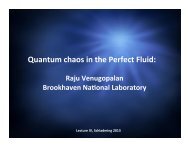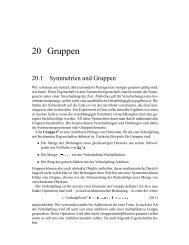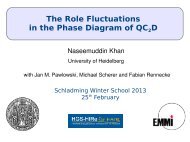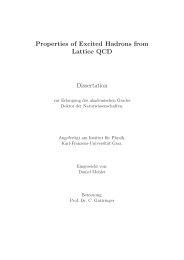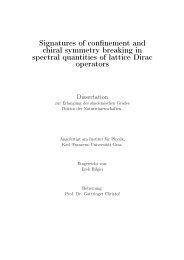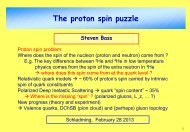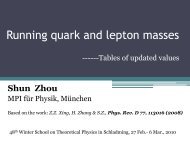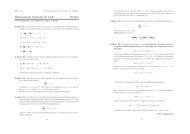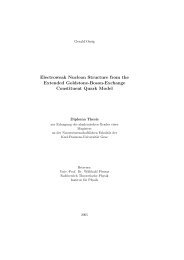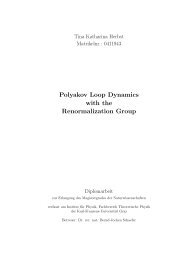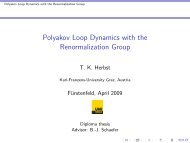The QCD Quark Propagator in Coulomb Gauge and - Institut für Physik
The QCD Quark Propagator in Coulomb Gauge and - Institut für Physik
The QCD Quark Propagator in Coulomb Gauge and - Institut für Physik
You also want an ePaper? Increase the reach of your titles
YUMPU automatically turns print PDFs into web optimized ePapers that Google loves.
Chapter 2. Chiral Symmetry Break<strong>in</strong>g <strong>in</strong> <strong>QCD</strong> 9<br />
Together with C <strong>and</strong> B the function M is a function of the spacelike squared momentum<br />
P 2 , the renormalisation po<strong>in</strong>t <strong>and</strong> the renormalised current quark masses. <strong>The</strong>re are two<br />
reasons for the def<strong>in</strong>ition (6.30) be<strong>in</strong>g the most suitable one for a mass function [Pol76].<br />
Firstly M(P 2 ) is the mass parameter for quarks, which appears <strong>in</strong> an operator product<br />
expansion of the quark propagator <strong>in</strong> the chiral limit. This means that it can be <strong>in</strong>terpreted<br />
as the parton mass <strong>in</strong> lepton hadron scatter<strong>in</strong>g. Furthermore it will get apparent that for<br />
considerations <strong>in</strong> <strong>Coulomb</strong> gauge <strong>and</strong> a conf<strong>in</strong><strong>in</strong>g potential the functions C <strong>and</strong> B are<br />
divergent, whereas M can be f<strong>in</strong>ite. With this expression for M one has to keep <strong>in</strong> m<strong>in</strong>d<br />
that the quark mass is a function of the momentum <strong>and</strong> thereby depends on the momentum<br />
scale of the process under consideration.<br />
In the chiral limit the symmetry of the <strong>QCD</strong> Lagrangian under the axial SU(N f ) assures,<br />
that <strong>in</strong> the fermion propagator no mass term can show up <strong>in</strong> each order <strong>in</strong> perturbation<br />
theory. <strong>The</strong> situation is analogous to BCS theory for superconductivity, where it is also<br />
impossible to obta<strong>in</strong> the energy gap <strong>in</strong> perturbation theory. Aga<strong>in</strong> like <strong>in</strong> BCS theory <strong>in</strong> our<br />
case the spontaneous break<strong>in</strong>g of chiral symmetry implies a non-perturbative mass term.<br />
<strong>The</strong>refore a theory, which is capable to describe explicit <strong>and</strong> spontaneous break<strong>in</strong>g of chiral<br />
symmetry, has to be able to specify the behaviour of perturbative <strong>and</strong> non-perturbative<br />
masses. <strong>The</strong> non-trivial behaviour of <strong>QCD</strong> under scale transformations entails that the<br />
parameters of the Lagrangian, <strong>and</strong> with this also the current quark masses, turn <strong>in</strong>to<br />
momentum dependent runn<strong>in</strong>g quantities. This circumstance is described by the Callan-<br />
Symanzik equation. Unfortunately their coefficients are only known <strong>in</strong> perturbation theory,<br />
which means that we can use this equation only for large momenta, where the coupl<strong>in</strong>g<br />
constant is small, as one can <strong>in</strong>fer from the Callan-Symanzik equation. In the lowest<br />
non-trivial order of perturbation theory it is possible to derive from the Callan-Symanzik<br />
equation the follow<strong>in</strong>g equation for the momentum dependence of the perturbative quark<br />
mass m k (P 2 ) at large Euclidean momenta [Pol76]<br />
P dm k(P 2 )<br />
= − 1<br />
(<br />
(P 2 )m<br />
dP 2π 2g2 k (P 2 ) 1 − m2 k (P 2 )<br />
ln<br />
(1 + P ))<br />
2<br />
P 2 m 2 k (P , (2.19)<br />
2 )<br />
where we used for the runn<strong>in</strong>g coupl<strong>in</strong>g the expression of first order perturbation theory<br />
g 2 (P 2 ) =<br />
48π 2<br />
(11N c − 2N f )ln(P 2 /Λ 2 ) . (2.20)<br />
In this context N c is the number of colours <strong>and</strong> N f is the number of active flavours. Λ is the<br />
<strong>QCD</strong> scale parameter. S<strong>in</strong>ce (2.19) is only valid for large momenta, the term proportional<br />
to m2<br />
P 2 can be neglected <strong>and</strong> one obta<strong>in</strong>s<br />
m k = (P 2 ) = m k (ν 2 )<br />
( ) g 2 (P 2 dm<br />
)<br />
, (2.21)<br />
g 2 (ν 2 )


